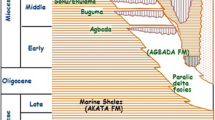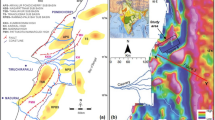Abstract
Nowadays, the failure to understand a hydrocarbon field’s geomechanics signifies an expensive risk in several complex drilling, well completion, and exploitation processes. Thus, the precise estimation of reservoir geomechanical parameters can lessen that risk and provide benefits all the way through oil and gas field’s lifespan. Several factors like compaction of sediments, lithology characteristics, overburden, hydrocarbon and capillary entry pressures add substantial effects to cause of abnormal pressure and resultantly affect the well design and stability. The aim of current study is to compute geomechanical properties such as overburden pressure and vertical effective stress and finally to define the lower and upper bounds (breakout and breakdown limits) of safe mud weight window by determining the pore pressure and fracture gradient for pre-drill planning in future exploration and real time monitoring in the Sinjhoro Field, the Lower Indus Basin of Pakistan. Current studies examined the wireline logs data of four wells drilled in the Cretaceous reservoir sands and seismic reflection data-based P wave velocity functions and describes a workflow for reliable estimation of geomechanical parameters. Our results revealed that high pore pressure (5000–7000 Psi) is predicated at reservoir zone and it increases in southeast directions. On the basis of pore pressure and fracture pressure, both lower (5388.89 Psi) and upper (6572 Psi) bounds for safe mud weight window are defined for safe drilling and well stability that will help future exploration and development in the Sinjhoro field. Both overburden pressure and vertical effective stress increase uniformly with depth but spatial variations are nonlinear and increasing in northwest directions. The present work will support the petroleum industry by reducing the borehole drilling cost with no compromising on environment and safety concerns.
Similar content being viewed by others
References
Fjaer, E.; Horsrud, P.; Raaen, A.M.; Risnes, R.; Holt, R.M.: Petroleum Related Rock Mechanics. Developments in Petroleum Science, vol. 33. Elsevier, Amsterdam (1992)
Schutjens, P.M.T.M.; Hanssen, T.H.; Hettema, M.H.H.; Merour, J.; De Bree, P.; Coremans, J.W.A.; Helliesen, G.: Compaction-induced porosity/permeability reduction in sandstone reservoirs. In: Society of Petroleum Engineers Annual Technical Conference and Exhibition, New Orleans, Louisiana. SPE-71337 MS, pp. 1–16 (2001). https://doi.org/10.2118/71337-MS
Sayers, C.M.; Schutjens, P.M.T.M.: An introduction to reservoir geomechanics. Lead. Edge 26, 597–601 (2007)
Smirnov, N.Y.; Lam, R.; Rau-III, W.E.: Process of integrating geomechanics with well design and drilling operation. In: American Association of Drilling Engineers Technical Conference, AADE-03-NTCE-28, pp. 1–5 (2003)
Zoback, M.D.; Moos, D.; Mastin, L.; Anderson, R.N.: Wellbore breakouts and in-situ stress. J. Geophys. Res. 90, 5523–5530 (1985). https://doi.org/10.1029/JB090iB07p05523
Siggins, A.F.; Dewhurst, D.N.; Dodds, K.J: Effective stress and the elastic response of reservoir sandstones and shales. In: Australian Society of Exploration Geophysicists 17th Geophysical conference and Exhibition, Sydney, pp. 1770–1773 (2004). https://doi.org/10.1190/1.1845168
Bachrach, R.; Banik, N.; Sengupta M.; Noelth, S.; Dai J.; Bunge G.; Flack B.; Utech R.: Effective-stress-based reservoir characterization in an offshore basin. In: SEG/New Orleans Annual Meeting, pp. 1620–1624 (2006). https://doi.org/10.1190/1.2369831
Gai, X.; Rungamornrat, J.; Klie, H.; Bangerth, W.; Wheeler, M.F.; Stoffa, P.L.; Sen, M.K.; Seifoullaev, R.: Fully integrated reservoir flow, geomechanics and seismic modeling: a tool for better reservoir characterization and geomechanical prediction using 4D seismic. In: SEG Annual Meeting Houston (2005)
Holbrook, P.W.; Maggiori, D.A.; Hensley, R.: Real-time pore pressure and fracture gradient 762 evaluation in all sedimentary lithologies. Soc. Pet. Eng. Form. Eval. 10, 215–222 (2005)
Moos, D.; Chang, C.: Relationships between porosity, pressure, and velocities in unconsolidated Sands. In: Proceeding Overpressure in Petroleum Exploration Workshop, Pau, France (1998)
Zaigham, N.A.; Mallick, K.: Prospects of hydrocarbons associated with fossil rift structure of southern Indus basins, Pakistan. AAPG Bull. 84, 1833–1848 (2000)
Hussain, M.; Chun, W.Y.; Khalid, P.; Ahmed, N.: Mahmood, A.: Improving petrophysical analysis and rock physics parameters estimation through statistical analysis of Basal sands, lower Indus Basin, Pakistan. Arab. J. Sci. Eng. 42, 327–337 (2017a). https://doi.org/10.1007/s13369-016-2128-0
Killings, G.; Umer, M.; Kassi, A.M.: Geology of Badin area of Pakistan. PAPG, Bull. 9, (2002)
Ahmed, N.; Khalid, P.; Shafi, H.M.B.; Connolly, P.: DHIs evaluation by combining rock physics simulation and statistical techniques for fluids identification of Cambrian to Cretaceous clastic reservoirs in Pakistan. Acta Geophys. 65, 991–1007 (2017). https://doi.org/10.1007/s11600-017-0070-5
Shah, S.M.I.: Stratigraphy of Pakistan. Mem. 12. Geological Survey of Pakistan, Quetta (1977)
Dix, C.H.: Seismic velocities from surface measurements. Geophysics 20, 68–86 (1955)
Khan, K.A.; Akhtar, G.; Ahmed, Z.; Khan, M.A.; Ahmed, N.: Wavelets—a computer based training tool for seismic signal processing. Pak. J. Hydrocarb. Res. 16, 37–43 (2006)
Khan, K.A.; Akhter, G.: Computer-based experiments for learning seismic signal processing concepts. Comput. Appl. Eng. Educ. 23, 959–966 (2015)
Pickett, G.R.: Acoustic character logs and their applications in formation evaluation. J. Pet. Technol. 15, 659–667 (1963)
Castagna, J.P.; Batzle, M.L.; Eastwood, R.L.: Relationship between compressional and shear wave velocities in clastic silicate rocks. Geophysics 50, 551–570 (1985)
Krief, M.J.; Garat, J.; Stellingwerff, J.; Ventre, J.: A petrophysical interpretation using the velocities of P and S waves (full wave form sonic). Log Anal. 58, 355–369 (1990)
Freund, D.: Ultrasonic compressional and shear velocities in dry elastic rock as a function porosity, clay content, and confining pressure. Geophys. J. Int. 108, 125–135 (1992)
Greenberg, M.L.; Castagna, J.P.: Shear-wave velocity estimation in porous rocks: theoretical formulation, preliminary verification and applications. Geophys. Prospect. 40, 195–209 (1992)
Gardner, G.H.F.; Gardner, L.W.; Gregory, A.R.: Formation velocity and density: the diagnostic for stratigraphic traps. Geophysics 39, 770–780 (1974)
Brandt, H.: A study on the speed of sound in porous granular media. J. Appl. Phys. 22, 479–486 (1955)
Biot, M.A.; Willis, D.G.: The elastic coefficients of the theory of consolidation. J. Appl. Mech. 24, 594–560 (1957)
Todd, T.; Simmons, G.: Effect of pore pressure on velocity of compressional waves in low porosity rocks. J. Geophys. Res. 77, 3731–3743 (1972)
Hottman, C.E.; Johnson, R.K.: Estimation of formation pressures from log-derived shale properties. J. Pet.Technol. 17, 717–722 (1965)
Siggins, A.F.; Dewhurst, D.N.; Tingate, P.R.: Stress path, pore pressure and microstructural influences on Q in Carnarvon Basin Sandstones. Proc. Offshore Technol. Conf. 1, 935–944 (2001)
Siggins, A.F.; Dewhurst, D.N.: Saturation, pore pressure and effective stress from sandstone acoustic properties. Geophys. Res. Lett. 30, 1089–1092 (2003)
Bowers, G.: Pore pressure estimation from velocity data: accounting for overpressure mechanisms besides under compaction. In: IADC/ SPE 27488, IADC/SPE Drilling Conference, pp. 515–530 (1994)
Eaton, B.: The equation for geopressure prediction from well logs. Soc. Pet. Eng. AIME SPE 5544, 1–11 (1975)
Terzaghi, K.: Theoretical Soil Mechanics. Wiley, Hoboken (1943)
Khan, K.A.; Bangash, A.A.; Akhter, G.: Raw seismic velocities aid predictions in mud program designs. Oil Gas J. 115, 22–26 (2017)
Mathew, W.R.; Kelly, J.: How to predict formation pressure and fracture gradient. Oil Gas J. 65, 92–106 (1967)
Khan, K.A.; Saqib, H.M.J.; Bangash, A.A.: Vel2Pore—a visual OIL program for computing overburden pressure, vertical effective stress and pore pressure from seismic velocities. Geophys. Res. J. 2, 1–6 (2016)
Khan, K.A.; Akhter, G.; Ahmad, Z.: OIL–output input language for data connectivity between geoscientific software applications. Comput. Geosci. 36, 687–697 (2010). https://doi.org/10.1016/j.cageo.2009.09.005
Author information
Authors and Affiliations
Corresponding author
Rights and permissions
About this article
Cite this article
Hussain, M., Ahmed, N. Reservoir Geomechanics Parameters Estimation Using Well Logs and Seismic Reflection Data: Insight from Sinjhoro Field, Lower Indus Basin, Pakistan. Arab J Sci Eng 43, 3699–3715 (2018). https://doi.org/10.1007/s13369-017-3029-6
Received:
Accepted:
Published:
Issue Date:
DOI: https://doi.org/10.1007/s13369-017-3029-6




